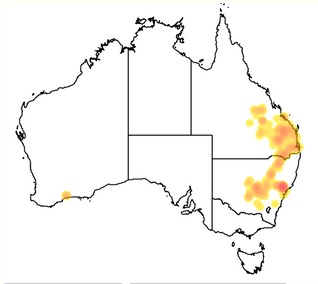Difference between revisions of "Acacia amblygona"
(Created page with "== General Plant Info == == Geographic distribution == == Identification == == Alkaloid content == == Other uses == == Extraction == == Cultivation == == Suppliers == ...") |
(→Geographic distribution) |
||
| (2 intermediate revisions by one user not shown) | |||
| Line 1: | Line 1: | ||
== General Plant Info == | == General Plant Info == | ||
| + | [[Acacia amblygona]] is a small, spreading shrub ranging from completely prostrate in habit to about 1.5 metres high. The phyllodes are generally ovate to elliptical up to 150 mm long, tapering to a sharp (pungent) point. The bright yellow flowers occur in globular-shaped clusters in the phyllode axils during winter and spring. The flowers are followed by seed pods about 50-70 mm long which are curved or twisted in shape | ||
== Geographic distribution == | == Geographic distribution == | ||
| + | [[File:amblygona-map.jpg]] | ||
== Identification == | == Identification == | ||
| Line 12: | Line 14: | ||
== Cultivation == | == Cultivation == | ||
| + | The prostrate form of [[Acacia amblygona]] (sometimes sold under the name 'Winter Gold') has been in cultivation for many years. It is a reasonably hardy ground cover which can spread to about 1-1.5 metres in diameter and is very spectacular when in flower. It prefers well drained soils in a sunny position. The upright forms are rarely seen in cultivation. | ||
| + | |||
| + | Propagation is relatively easy by normal seed raising methods following pretreatment by soaking in boiling water or by scarification. Cuttings are also reasonably successful and this is the only method that should be used for the prostrate form to be sure of retaining the prostrate habit. | ||
== Suppliers == | == Suppliers == | ||
Latest revision as of 07:05, 21 January 2015
Contents
General Plant Info
Acacia amblygona is a small, spreading shrub ranging from completely prostrate in habit to about 1.5 metres high. The phyllodes are generally ovate to elliptical up to 150 mm long, tapering to a sharp (pungent) point. The bright yellow flowers occur in globular-shaped clusters in the phyllode axils during winter and spring. The flowers are followed by seed pods about 50-70 mm long which are curved or twisted in shape
Geographic distribution
Identification
Alkaloid content
Other uses
Extraction
Cultivation
The prostrate form of Acacia amblygona (sometimes sold under the name 'Winter Gold') has been in cultivation for many years. It is a reasonably hardy ground cover which can spread to about 1-1.5 metres in diameter and is very spectacular when in flower. It prefers well drained soils in a sunny position. The upright forms are rarely seen in cultivation.
Propagation is relatively easy by normal seed raising methods following pretreatment by soaking in boiling water or by scarification. Cuttings are also reasonably successful and this is the only method that should be used for the prostrate form to be sure of retaining the prostrate habit.
